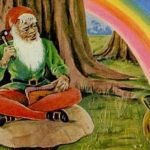 Movies and TV
Movies and TV  Movies and TV
Movies and TV  Creepy
Creepy 10 Lesser-Known Shapeshifter Legends from Around the World
 Animals
Animals 10 Amazing Animal Tales from the Ancient World
 Gaming
Gaming 10 Game Characters Everyone Hated Playing
 Books
Books 10 Famous Writers Who Were Hypocritical
 Humans
Humans 10 of the World’s Toughest Puzzles Solved in Record Time
 Mysteries
Mysteries 10 Scientific Mysteries We Don’t Fully Understand
 Weird Stuff
Weird Stuff 10 Celebrities Who Have Admitted to Alien Encounters
 Our World
Our World 10 Surprising Secrets of Notre Dame Cathedral
 Miscellaneous
Miscellaneous 10 Intriguing Origins of Popular Carnival Rides
 Movies and TV
Movies and TV 10 Actors Dragged out of Retirement for One Key Role
 Creepy
Creepy 10 Lesser-Known Shapeshifter Legends from Around the World
 Animals
Animals 10 Amazing Animal Tales from the Ancient World
Who's Behind Listverse?

Jamie Frater
Head Editor
Jamie founded Listverse due to an insatiable desire to share fascinating, obscure, and bizarre facts. He has been a guest speaker on numerous national radio and television stations and is a five time published author.
More About Us Gaming
Gaming 10 Game Characters Everyone Hated Playing
 Books
Books 10 Famous Writers Who Were Hypocritical
 Humans
Humans 10 of the World’s Toughest Puzzles Solved in Record Time
 Mysteries
Mysteries 10 Scientific Mysteries We Don’t Fully Understand
 Weird Stuff
Weird Stuff 10 Celebrities Who Have Admitted to Alien Encounters
 Our World
Our World 10 Surprising Secrets of Notre Dame Cathedral
 Miscellaneous
Miscellaneous 10 Intriguing Origins of Popular Carnival Rides
Ten Things You Didn’t Realize about Leprechauns
The lore surrounding leprechauns may have originated in Ireland. Still, whenever March rolls around in the United States, there seem to be little redheaded men wearing green all over the place. St. Patrick’s Day is obviously a huge holiday—and a big excuse to party—for many Americans. And it’s the one day every year when you absolutely must wear something green, lest you get pinched by everyone around you!
Between that and other leprechaun lore, including symbols of good luck and pots of gold at the end of the rainbow, leprechauns seem to be all over the place. They’ve been portrayed in television and movies, they wind up on the front of cereal boxes, and they are both lampooned and honored in a variety of ways by Irish-American descendants—and, more recently, their counterparts from pretty much every background.
But the story of leprechauns actually goes back way further than a springtime holiday, and it has far more interesting aspects to it than you ever realized. In this list, we’ll take a long look at ten fascinating facts about leprechauns. These were things you likely never knew about the myths surrounding these little guys, their origins, their history, and their legacy. Are you feelin’ lucky enough to read on?
Related: Top 10 Strange and Eerie Mysteries in Ireland
10 Leprechauns Settled Ireland?
According to legend, leprechauns were actually in Ireland long before the arrival of humans from the rest of the British Isles and elsewhere. See, leprechauns are not people like we are; instead, they are said to be fairies. These fairies are unique in their biological makeup and temperament, and they didn’t migrate to Ireland ages ago like humans did.
As the legend does, they supposedly originated from a family of what is called “Tuatha Dé Danann.” This family was composed of magical beings that existed to serve the goddess Danu. That goddess was a well-known Gaelic spirit who lorded over the land.
The leprechauns were created and then thrived in order to do her bidding, protect her land, and see after her assets and legacy on Earth. As such, they originated in Ireland far before people got to the island. When humans finally did discover the land and make a move to settle it, they were supposedly confronted by a group of leprechauns who had been there already, working hard at doing Danu’s bidding.
From the very start, then, leprechauns had more than just a whimsical aspect about them. They had the goddesses’ backing, and they had first rights to the region that would become known as Ireland![1]
9 Carlingford’s Leprechaun Evidence
In 1989, an Irish businessman claimed that he found rock-solid evidence of the presence of leprechauns. The evidence came after he’d heard a scream from deep down inside a wishing well, he asserted. When he went to investigate the source of the scream, he supposedly found gold coins, a tiny suit, and some bones—remnants of some very tiny creature that had perished down in the well.
Shocked, he quickly realized that the combination of that evidence could only point to one thing: the sure-fire presence of leprechauns! And like any good fairy hunter, he preserved the evidence he did find in a glass case to be put on display. You know, so any naysayers would be overcome with the cold, hard truth!
Then, he created an annual tradition in which others now go out and “hunt” for leprechauns in Carlingford. There is said to be a fairy cavern upon the side of a hilly incline where these leprechauns supposedly live. At the annual “leprechaun hunt,” visitors can go across the hills and find more than 100 scattered and hidden ceramic leprechauns.
The “hunter’s license” that this event requires costs a few pounds, so the businessman proved himself to be savvy enough to charge for the pleasure. But the event has become an annual celebration in Carlingford, with hunters from all over searching for leprechauns, gold bars, and more “proof” of the fairies’ existence in Ireland.[2]
8 No Girls Allowed!
There are no female leprechauns. According to old books that have covered the stories of leprechauns going back centuries, there have only ever been male versions of the little species. Even going back to Fairy Legends and Traditions from the South of Ireland, published by author Thomas Crofton Croker way back in 1825, there are no mentions of female leprechauns existing in the mortal realm.
Some say that’s because leprechauns are actually male fairies who were previously banished from their fairy colonies and families for a variety of reasons. After banishment, they were ordered to carry out the rest of their whimsical lives as leprechauns in their male-only colony in present-day Ireland.
Other sources claim leprechauns weren’t banished from their fairy colonies because they did something wrong. Instead, lore holds these creatures were simply the unwanted male children of fairy communities. For a variety of reasons, they were discarded and sent off to live in their new land away from the community that was supposed to have raised them. Pretty depressing, right?
Either way, there are two ways for leprechauns to maintain and grow their population once they are sent off to their new living arrangements. They can either (a) mate with the females of other species to supposedly produce more leprechauns or (b) wait around patiently and rely on other banished fairies to maintain the population into the future. Regardless, this detail sure makes you look at leprechauns in a different (and even more sympathetic) light, doesn’t it?[3]
7 Going Santa Style
We know leprechauns as wearing all green, but they weren’t always depicted that way. For centuries, leprechauns were said to have worn red. In all kinds of Irish written lore, they were described as being shoemakers with pots of gold hidden at the end of rainbows—which, yeah, we’re still on board with today—but their outfits were made up of bright red that allowed them to easily spot each other as opposed to the green we know today.
Take the author Samuel Lover’s 1831 work Legends and Stories of Ireland. In it, Lover writes that all leprechauns have a red square-cut coat that is laced with gold trimmings, as well as a bright red hat that goes along with large black buckles on their belts and shoes. That sounds a little more like Santa Claus than it does the modern leprechaun, doesn’t it?
And Lover was not alone in his description. Many other authors centuries ago described these mischievous and energetic little fairies in the exact same way: with three-cornered hats and bright red clothes. It wasn’t until Irish poet William Allingham—who died at the very end of the 19th century—wrote a memorable poem about leprechauns wearing green that the new look stuck.
A large part of that change could be to more closely associate leprechauns with Irish customs, colors, and traditions. After all, green began to be associated with everything to do with Ireland by the late 19th century, so it only makes sense that leprechauns would join that line. Or, if you’re more whimsical about it, perhaps you can believe they switched to green to better blend in with the grass along the Irish countryside![4]
6 The Dutch Have Leprechauns, Too!
Amazingly, leprechauns aren’t an Irish-only thing. Other societies around the world have similar tales and fables from their ancient past. The Hawaiians have the Menehune, for example. They believe these Menehune are tiny, secretive dwarf people who dwell high up in rainforest jungles and live quietly as best they can away from human encroachment.
But the Irish isn’t the only culture that believes tiny fairies or fairy-like people are dwelling about. In fact, one culture that believes this to be true is MUCH closer to Ireland than the Hawaiians!
In the Netherlands, there is said to be a race of gnomes known as “kabouters” who are very similar to the leprechauns that live in Ireland. These Holland-based gnomes are supposedly very tiny and very hairy. They tend to live underground, most often in holes that they’ve dug out in sloping hills. They tend to be solitary creatures, and they’re even a little bit vindictive!
Legend has it these kabouters like to spy on people, and if people spy on them, they come after the poor humans who dared to explore. Oh, and just like leprechauns (er, you know, leprechauns before their outfit switch), kabouters are always depicted as wearing little red suits with pointy red hats. Clearly, there are quite a few parallels![5]
5 Holding the Purse Strings
According to legend, the leprechauns are the bankers of the fairy world. Of course, their main work is making shoes. They are well-known among myth followers and even casual observers for their role in producing shoes. Those shoes, in turn, are sent off to all the other fairies of the world, and the leprechauns make their money and thrive in this little economy.
Sounds simple (and pretty popularly known at this point), right? And since fairies love to dance and romp so much, they always need new shoes from their shoemakers. Cha-ching! But what’s interesting is that leprechauns have other ways to make bank (literally) that go beyond just cobbling together footwear!
Leprechaun legends claim that these little red-haired men are the ones who quite tightly hold the purse strings in the fairy world. See, it’s no accident that leprechauns are often depicted as lucky and have those infamous pots of gold around them. That gold is said to be their bank stash, from which they can dole out money to other fairies in need.
The leprechauns guard their assets carefully and shrewdly, giving out a few coins here and there—always to be paid back in time. It all came to a head centuries ago, myths claim, when marauders from Denmark landed on Ireland hunting treasure. The leprechauns hid their pots of gold, avoided the aggressive Danes, and then circled the wagons to protect their pricey assets forever after![6]
4 The Smallest Leprechaun Colony Ever
In 1946, a man named Dick Fagan returned to Oregon after serving in World War II. He got a job as a reporter at the Oregon Journal and set out to cover local news, politics, and other events around the city of Portland.
That should have been the whole story, perhaps, but Fagan wasn’t interested in just being a news reporter. He also had a bit of a creative side to him. That came out one day a few years later when he noticed a tiny block of concrete in the city that used to be the foundation point for a light pole. With the light pole gone, some grass had sprung up, and Fagan got an idea.
He began writing newspaper columns about a supposed leprechaun named Patrick O’Toole, who lived in that cement-encircled grassy area in Portland. It was a very tiny spot, and O’Toole, Fagan explained in his columns, was a very tiny man. Obviously, the details were all made up, but Fagan ran with a whole story about O’Toole’s colony of fellow leprechauns. In time, the journalist even added flowers and other decorations near the cement outcropping—and he even made a sign for the site.
The whole story is goofy, but it proved to be a hit with the public. Over the next several decades, Portland residents responded positively to the supposed leprechaun tale. By 1976, it became an official city park despite its incredibly tiny size.
In the years since, other contributors have carried out Fagan’s goofy legacy with more leprechaun-related improvements. The city has moved the “park” a couple times to put together various construction projects, but the location—now officially known as Mill Ends Park—lives on well into the 21st century.[7]
3 Don’t Fence ‘Em In!

In 1958, workers in Ireland were tasked with building a high fence to enclose a certain area of the hilly countryside. The task seemed simple enough, and the workers in question had done jobs like that plenty of times before. But there was one major problem: They believed the area they were enclosing was a spot where leprechauns tended to live.
Thus, they wanted to not build the tall fence, as it would trap those supposed leprechauns within an enclosed space and leave them unable to move to get food and water and generally live their fairytale lives. In total, more than 20 workers boycotted building the fence. They wanted the land around there not to be disturbed, dug up, or desecrated in any way because of the supposed leprechauns that called it home.
Then-president of Ireland Éamon de Valera was quickly put into a difficult spot when it came to whether or not the workers should be punished. Believers who argued the leprechauns really did live there noted that “the land is a fairy palace and must not be desecrated.” Of course, it’s possible that the workers simply chose not to build a fence on that day because they didn’t feel like working.
Thus, the leprechauns became a simple excuse for all that. But we prefer to believe that they really did know some leprechauns lived in the area—and their disobedience was thus all the more righteous in its brazen push.[8]
2 The Law Loves Leprechauns!
Whenever surveys are taken about leprechauns across Ireland, the results consistently come back with about one-third of the population believing in them as being real. That number fluctuates a bit and has changed some over the years. And, of course, it’s certainly possible that survey respondents are simply trolling the survey takers when answering that they think leprechauns really do exist out there dug deep into the hillsides.
But still, there are so many Irish people who back leprechauns as being legitimate that it has left lawmakers in a bit of a bind when it comes to human (er, uh, fairy) rights! In 2009, 236 “surviving leprechauns” were granted protection in various human rights and legal manners under the European Habitats Directive. Yes, you read that right: European law actually does protect leprechauns just as it would for any other endangered species or rare habitat within its jurisdiction.
Specifically, the Slieve Foye mountain caverns were protected by the European Union when they were given heritage status that year. Those caverns are believed to contain at least 236 leprechauns who hide out in there and stay as far away from people as they possibly can. Of course, the law also very specifically protects real flora and fauna in those mountain caverns. But it’s definitely more fun to think about how the EU is looking out for its leprechaun citizens![9]
1 Leprechaunism Is a Disorder
Believe it or not, there is a very rare disorder that afflicts babies, and it is named after leprechauns. Also known as Donohue syndrome, this disorder has to do with insulin resistance. Basically, an extremely small percentage of infants suffer from insulin resistance after they are born. In turn, they find it extremely difficult to gain weight, and they suffer through exceedingly slow and perilous growth rates. The disorder forces them to suffer through extremely low muscle mass and growth through infancy, as well as dangerously low body fat levels.
The disorder is so rare that it has only been seen in the world a few dozen confirmed times. In fact, there are only about 50 known and legitimized cases of the disorder that have been listed in medical literature. So saying there’s a one-in-a-million shot for a baby to suffer through this is even understating it a bit.
Still, leprechaunism can seriously affect the endocrine system and make for life-threatening growth delays, so doctors take it very seriously when they see it. They have also tried to rename the syndrome to its Donohue moniker, too, as a way to walk back any potentially negative or offensive associations between these babies and leprechauns.[10]








